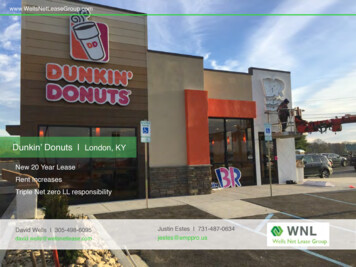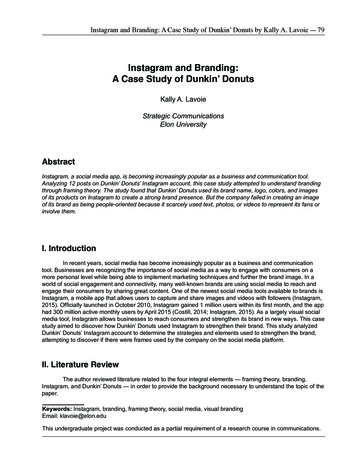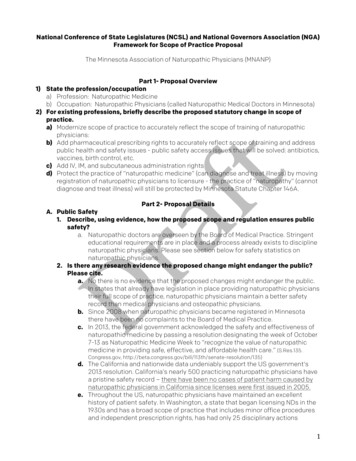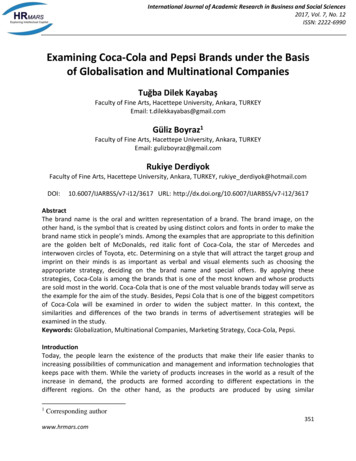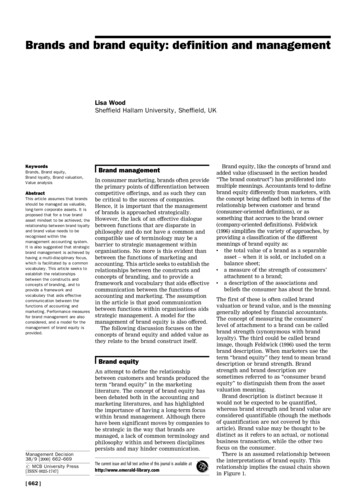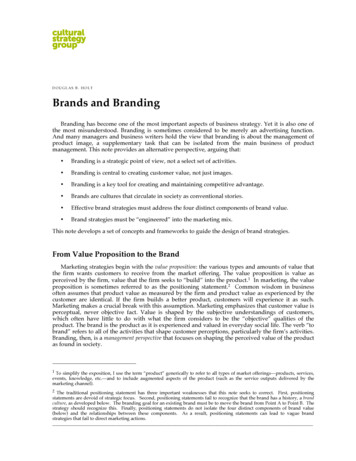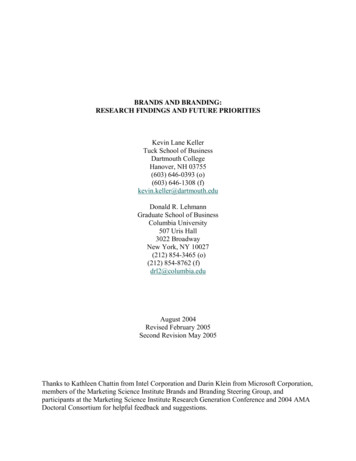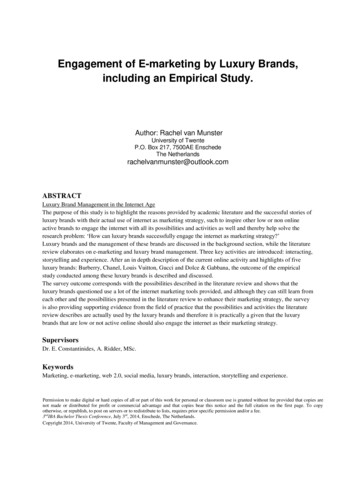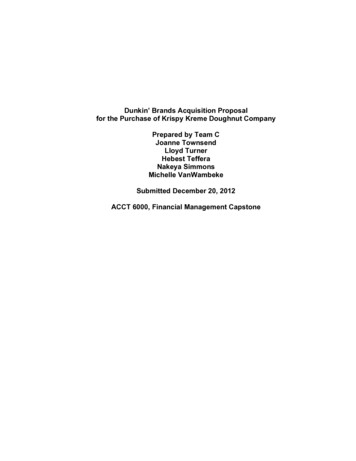
Transcription
Dunkin’ Brands Acquisition Proposalfor the Purchase of Krispy Kreme Doughnut CompanyPrepared by Team CJoanne TownsendLloyd TurnerHebest TefferaNakeya SimmonsMichelle VanWambekeSubmitted December 20, 2012ACCT 6000, Financial Management Capstone
Table of ContentsI. IntroductionII. Initial Proposal Presented to Dunkin’ Brand’s Board of DirectorsA.B.C.D.Industry OverviewDunkin’ Brands Business StrategyDunkin’ Brands Corporate OrganizationProposalIII. Report on Krispy Kreme’s OperationsA. Krispy Kreme Company HistoryB. Management Team of Krispy KremeC. Financial StrengthsD. Operational StrengthsE. Franchise and Royalty OperationsF. Trademarks and Intellectual PropertyG. Anti-takeover provisionsH. Pending Legal IssuesI. Regulatory RequirementsJ. Internal ControlsK. Related Party TransactionsL. Krispy Kreme SWOT AnalysisIV. Analysis of Krispy Kreme Performance Ratios and TrendsA.B.C.D.E.F.G.Operating PerformanceReturn on InvestmentAsset UtilizationLiquidityCash FlowSolvencyMarket PerformanceV. Krispy Kreme Risk Factors and Risk ManagementA. Risk Management PoliciesB. Insurance
C.D.E.F.G.Buildings and Equipment RiskBusiness Profitability & Interruption RiskRisk Associated with Liabilities to Other PartiesCurrency RickRisks Associated with Other AssetsVI. Dunkin Brand Risk Factors to Be Considered in the AcquisitionA.B.C.D.E.F.G.Risk Management PoliciesInsuranceBuildings and Equipment RiskBusiness Performance & Interruption RiskRisk Associated with Liabilities to Other PartiesRisks Associated with Other AssetsCurrency RiskVII. Analysis of Financing OptionsA. Sources of Debt FinancingB. Sources of Equity FinancingVIII. Dunkin’ Brands Capital Structure AnalysisIX. Krispy Kreme Valuation for AcquisitionA.B.C.D.E.F.Market ValueEnterprise ValueBook ValueFirm Value & Intrinsic ValueForward Valuation, considering efficiencies and synergiesValuation SummaryX. Proposed Acquisition Financing MethodA. Stock SwapB. Dunkin’ Brands Optimal Target Capital StructureC. Strategic Growth Plan including Krispy KremeXI. Conclusion
I. IntroductionIt is the recommendation of this committee that Dunkin’ Brands proceeds withan offer to acquire Krispy Kreme Doughnut Company. The acquisition will be financedwith a stock swap of three shares of KKDC common stock in exchange for one shareof DNKN common stock to Krispy Kreme stockholders. This report presents a thecomprehensive research and analysis that was conducted by the Due DiligenceCommittee over a seven week period.II. Initial Proposal Presented to Dunkin’ Brand’s Board of DirectorsA. Industry OverviewThe coffee shop industry is approximately 25.3 billion in sales and includesabout 20,000 stores. The growth in this industry is growing from 25.3 billion (2009) insales worldwide. The coffee-shop industry employs approximately 20 million peoplewith the top 50 companies in this industry making up 70% of sales which wouldinclude Starbucks being the top earning revenue company. There is not an industrysource of data on global coffee shop revenue; however the trend has seen growth inall major markets around the world. (PRweb, 2012)As we look at the Specialty Coffee Industry or Gourmet Coffee as many maycall it, one can find that it is segmented into many areas. These areas would rangefrom: Drive thru, inner retail, Coffee houses, and other venues related to sports andetc. With the segments are several segments within this core group. We arespeaking of companies in this industry having: Consumer packaged goods, FoodService, and Product Supply. It is said that “Coffee is the second largest commodity
market next to oil, and growth is expected to continue at a strong pace for theforeseeable future.” (“Coffee Distribution Business,”)Because of the high demand of coffee in the world, this astounding industry isexpected to continue constant growth. According to the IBIS World, the industryregained revenues as the consumer spending began to rebound because of the quickfix that coffee provides. IBIS is very optimistic about the industry’s growth for 2011 to2012 with the condition of the economy. This led their hope to depend on theexpansion for health menu options. Major operators like and Dunkin' Donuts andStarbuck’s have expanded their menus to healthier nontraditional items to aiding themin their turnaround with battling the recession. We believe that in the next 5 years,coffee and snack shops will increase in profit substantially to the growing economyand the consumers’ repetitive need to function on coffee. (PRweb, 2012)Even though there is potential for growth, any company involved can facesubstantial risk factors. One main factor would be facing the challenge of not havinghuge amounts of debt. Having debt can increase the risk of any company’s growth.Among these important risks are the following: As of March 26, 2011, on an asadjusted basis after giving effect to this offering and the application of the netproceeds there from, Dunkin Donuts would have had total indebtedness ofapproximately 1.5 billion and their substantial debt could limit their ability to pursuetheir growth strategy. Their plans depend on initiatives designed to increase sales andimprove efficiencies, cost, and effectiveness of operations. Failure to achieve orsustain these plans could affect their performance adversely. General economicfactors and changes in consumer preference may adversely affect their performance;
Dunkin Donuts face competition that could limit their growth opportunities; and theirplanned future growth will be impeded, which would adversely affect revenues.Furthermore, if their franchisees cannot open new domestic and internationalrestaurants as anticipated, this would further affect their growth. (“Dunkin Brands”,2011)Dunkin Donuts main competitor is Starbucks, and like any other industry theyare both highly competitive. Currently, Starbucks is the industry leader with a hold on32.6% of the market share. Dunkin Donuts has about 23% of the market share andGreen Mountain Coffee Roasters has only 8.4%. It is also to note that competitors arealso from nontraditional coffee sources such as McDonald’s.B. Dunkin’ Brands Business StrategyDunkin’ Brands is well positioned to deliver sustainable long term growth andshare holder value. We have two strong, established brands, significant opportunity toprofitably to grow our brands both in the US and around the world, a highlyexperienced management team and an asset-light franchised business model withhigh margins, low capital expenditures requirements, and strong free cash flowgeneration.Our mission is clear: To be the premier, global quick service restaurantfranchisor with a leading position in the coffee, bakery and ice cream segments of theQSR category. Our strategies for delivering on this mission are equally clear. Weplan to increase comparable store sales and profitability of Dunkin’ Donuts US,accelerate Dunkin’ Donuts US contiguous store expansions, and drive acceleratedinternational growth for both Dunkin’ Donuts and Baskin-Robbins US.
C. Dunkin’ Brands Corporate OrganizationAs of December 31, 2011, excluding employees at our company-ownedrestaurants, we employed 1,128 people, 1,022 of whom were based in the U.S. and106 of whom were based in other countries. Of our domestic employees, 431 workedin the field and 591 worked at our corporate headquarters or our satellite office inCalifornia. Of these employees, 159, who are almost exclusively in marketingpositions, were paid by certain of our advertising funds. In addition, our PeterboroughFacility employed 71 full-time employees as of December 31, 2011. Other than the 46employees in our Peterborough Facility who are represented by the NationalAutomobile, Aerospace, Transportation & General Workers Union of Canada, Local462, none of our employees is represented by a labor union, and we believe ourrelationships with our employees are healthy. Our franchisees are independentbusiness owners, so they and their employees are not included in our employeecount.D. ProposalDunkin’ Donuts coffee shops have was around twenty years before Starbucks gotits start. This chain grew quickly in New England, and then spread across the UnitedStates and overseas. Dunkin’ Brands has clearly stated its mission as follows: “To bethe premier, global quick service restaurant franchisor with a leading position in thecoffee, bakery, and ice cream segments of the QSR category.” The strategies forachieving this mission include the following goals for the Dunkin’ Donuts operatingsegments:
-Increase comparable store sales and profitability of Dunkin’ Donuts U.S.-Accelerate Dunkin’ Donuts U.S. contiguous store expansion-Drive accelerated international growth for Dunkin’ Donuts-Increase comparable store sales of Baskin RobinsIt is understood that many successful companies are to gain control over their industrythrough acquisition over companies that can provide a different element to who theyare. As we analyze potential acquisitions, we are striving to acquire a company that issimilar to its competitors, allowing Dunkin Brands to add value to its name with aninnovative process. Through brief analysis, we discovered that Krispy Kreme is apotential acquisition that can add the right element to future growth.Krispy Kreme is a leading branded retailer and wholesaler of high-quality doughnuts,complementary beverages and treats and packaged sweets. The Company’s principalbusiness, which began in 1937, to owning and franchising Krispy Kreme stores, atwhich a wide variety of high-quality doughnuts, including the Company’s OriginalGlazed doughnut, are sold and distributed together with complementary products,and where a broad array of coffees and other beverages are offered. In using thelongevity that they have had in their industry, they have built a name that has carriedthem to now. With our success we can merge together to one complete product andeliminate them as a competitor. This would allow our consumer base to increasebecause of their specialty with Donuts and give them a chance to experience adifferent side of coffee with what we offer.
III. Report on Krispy Kreme’s OperationsA. Krispy Kreme Company HistoryKrispy Kreme’s origin is a family business established in 1933 by VernonCarver Rudolf and family when they purchased a doughnut shop and moreimportantly, the secret recipe to the doughnuts made by Krispy Kreme. Thecompany’s original doughnut shop was located in Paducah, Kentucky. Seeking togrow the business, Mr. Rudolf moved operations first to Nashville, Tennessee.Breaking from the other family owners in the initial operation, Mr. Rudolf opened astore in Winston-Salem, North Carolina, where the company continues to operate itslarge-scale material and equipment-manufacturing segment. Nation-wide growthproceeded throughout the years by opening stores throughout the country.In the following years, the company developed automated manufacturingtechniques while maintaining the basic original recipe. The uniqueness of theautomated manufacturing and recipe is what sets Krispy Kreme apart from otherdoughnut stores and suppliers.Ownership of Krispy Kreme eventually passed from family to corporate whenBeatrice Foods Company purchased it in 1976 following the death of the founder, Mr.Rudolf. Subsequently in 1982, a group of Krispy Kreme franchisee purchased thecompany from Beatrice. This new organization focused on developing the Krispy
Kreme brand name through creating a customer experience and loyalty associatedwith the strengths of the company – the manufacturing process and the unique recipe.Current operations of the corporation are structured whereby two senior vicepresidents report to the CEO. One vice president is responsible for franchise andcompany store operations, and the other is responsible for wholesale operations. Inaddition to the operational executives, 5 additions senior vice presidents report to theCEO to oversee functional aspects of the corporation such as finance, marketing,human resources, general counsel, and international operations.Krispy Kreme went public in 2000 with a successful IPO price of 21/share.Financial trouble soon followed when in 2004 the SEC questioned the company’saccounting for the repurchase of franchise stores. The stock price fell a low of 1.01in 2009. The questionable accounting practice involved expensing the repurchase ofa franchise instead of capitalizing the repurchase. This was done by calling theexpense a “reacquired franchise right”. As a result, income appeared inflated for thistime period due to the high expense. With the change in accounting practices inrecent years, Krispy Kreme’s income and profitability has been greatly reduced since2004, and better reflects the nature of its operations. This accounting issue hasresulted in weakened investor confidence.KKDC currently operates in 19 states plus DC as follows: Alabama, DC,Florida, Georgia, Indiana, Kansas, Kentucky, Louisiana, Maryland, Michigan,Mississippi, Missouri, New York, North Carolina, Ohio, South Carolina, Tennessee,Texas, Virginia, West Virginia. Franchises in 29 states, adding to the list the states of
Arizona, Arkansas, California, Colorado, Connecticut, Hawaii, Idaho, Illinois, Iowa,Nebraska, Nevada, New Jersey, New Mexico, Oklahoma, Oregon, Pennsylvania,Utah, Washington, and WisconsinB. Management Team of Krispy KremeThe top management team at KKDC consists of 8 executives with extensiveexperience in either restaurant chain operations or in their area of responsibility. Withthe exception of the Vice President of Human Resources and the Vice President ofSupply Chain and Off-Premises Operations, all member of the executive managementteam joined the company after the “accounting scandal” of 2004. A brief overview ofthe team and their background is presented as follows:Current CEO James H Morgan was asked to become CEO in January 2008,but had been on the board of directors since 2005. His background is in inve
Krispy Kreme is a leading branded retailer and wholesaler of high-quality doughnuts, complementary beverages and treats and packaged sweets. The Company’s principal business, which began in 1937, to owning and franchising Krispy Kreme stores, at which a wide variety of high-quality doughnuts, including the Company’s Original
